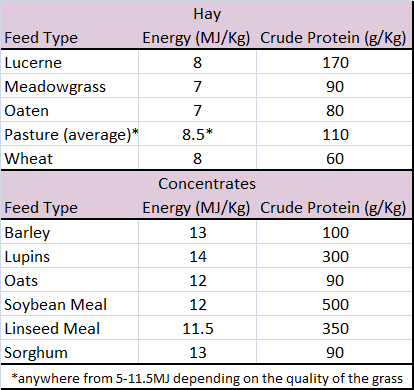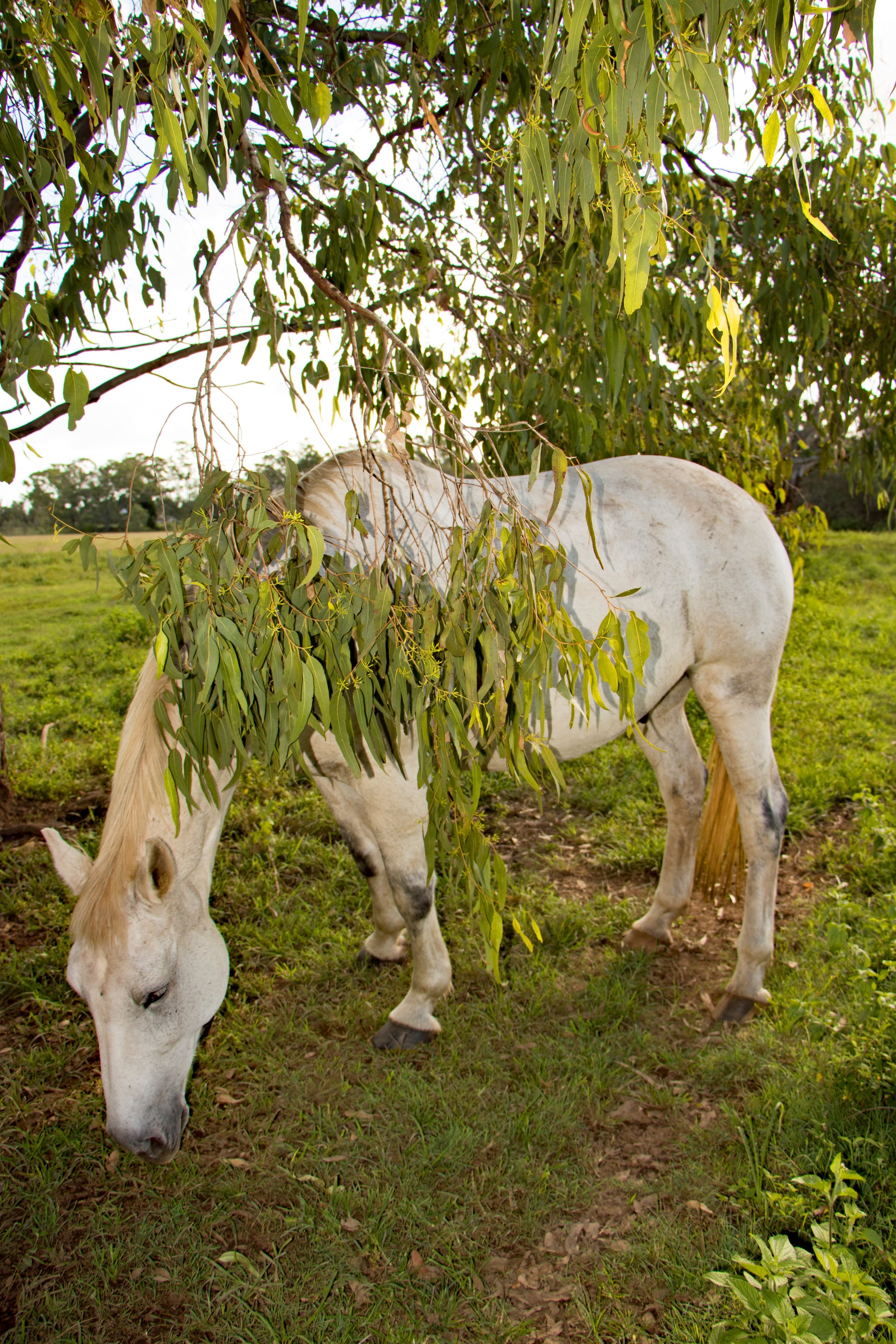Feeding Your Horse (Part 2): Calculating Feeding Requirements
Feeding a horse can be complicated, so understanding the science behind it can help you achieve the best results for your horse.
Today we are going to share some tips on calculating feed for your horse.
With such a wide variety of feeding options and a massive number of variables with every single horse (size of paddock, turn out hours, paddock mates, along with physiological changes), it’s a small wonder so many of us have questions about feeding our horses.
Calculating feed quantities is absolutely a mix of science and art. We will share the science and allow you to play with the art depending on your situation.
So here are some facts:
a) A guide to calculating feed breakdown based on a healthy horse at various stages of health
- Horses require at least 1.5% of their body weight in food each day, and can eat up to a maximum of 2.5-3% depending on energy requirements, activity level, age, and size of the horse (notably weanlings and ponies will exceed these maximums if on good pasture).
- Roughage (including grass) should make up a minimum of 50% of their total diet, and recommended to be at least 1.5-2% of their body weight. Roughage is exceptionally important to aid digestion, feed gut flora and provide satiety.
- It is with the above point that you can assume that a lot of healthy, mature horses that are maintaining or in light work can maintain solely or almost solely on roughage, with very little grain supplementation, with horses in intense work needing a higher percentage of concentrate supplemented (see charts a & b).
- Older horses, growing horses, reproducing horses or horses with illnesses have varying requirements based on body condition, muscle condition, disease and growth requirements, and require more in-depth analysis for feeding calculations.
- Concentrates (high sugar/energy foods) fed at greater than 0.5% of your horses’ body weight in a single feed can seriously disrupt the gut flora and digestion, and predisposes your horse to all manner of gastric problems including ulcers, colic and laminitis. If your horse needs a larger percentage of concentrate in the feed, ensure to split the feeds over several meals to avoid problems (chart c).
- Feeding more than 50% of the total feed as a concentrate has also been well documented to increase the risk of several problems including laminitis and colic.
- Large feeds (greater than 0.25% of the horses body weight) of concentrates should not be offered within 1 hour of stressful situations (heavy exercise, transport), nor to exhausted horses.
b) An approximation of the feed for a horse, which can alter depending on body condition, feed selection and general health.
c) Maximum recommended concentrate per feed (not day) by horses body weight
Feeding for energy
While we initially start by looking at the total weight of food compared to body weight, we must also consider the energy requirements.
Example 1:
A 500kg horse in light work with a body condition score of 5 requires 69.9 MegaJoules per day to maintain healthy energy and weight (see Part 1: Calculating Energy Requirements for full details).
Energy Requirement: 69.9 MJ
Estimated feed intake based on weight: 9.75kg
Roughage intake approximation: 7.8-9.75kg
Concentrate intake approximation: 0-1.95kg (Note: maximum concentrate in single feed should not exceed 2.5kg for a 500kg horse)
Through pasture yield calculations, we estimate that this horse is eating at least 6kg of pasture each day (I'll go more into detail on how to calculate that in a later segment).
average energy and protein from common feed souces
Pasture average intake: 8.5MJ/kg or 51MJ
Leaving 18.9MJ to make up in additional food, at least 1.8kg in roughage.
Lucerne: 8MJ/kg x 1.8kg = 14.4MJ.
There is now 4.5MJ left to feed for.
Barley: 13MJ/kg. 350g will provide 4.5MJ.
Total Weight of Food: Pasture (6kg) + Lucerne (1.8kg) + Barley (350g) = 8.15kg, or 1.63% of total body weight.
This is less than the 1.75% body weight recommendation, but contains higher than 50% roughage and meets the required energy needs for a 500kg horse in light work.
Example 2
Same horse, but now it is winter and the pasture is not yielding as well.
Energy Requirement: 69.9 MJ
Estimated feed intake: 9.75kg
Roughage intake approximation: 7.8-9.75kg
Concentrate intake approximation: 0-1.95kg (Note: maximum concentrate in single feed should not exceed 2.5kg for a 500kg horse)
Through pasture yield calculations, we estimate that this horse is eating at least 6kg of pasture each day.
Pasture average intake: 5MJ/kg or a total of 30MJ.
Leaving 39.9MJ to make up in additional food, at least 1.8kg in roughage.
Lucerne: 8MJ/kg x 1.8kg = 14.4MJ.
There is now 25.5MJ left to feed for.
Barley: 13MJ/kg. 1.95kg would offer the missing 25.5MJ.
Total Weight of Food: Pasture (6kg) + Lucerne (1.8kg) + Barley (1.95kg) = 9.75kg, or 1.75% of total body weight.
Hopefully, this has given you a great starting point at calculating feeding requirements. Later this month we will release more information on nutrient requirements and estimating your pasture's yield.
Feeding a horse is a combination of art and science. Each horse has different requirements depending on their age, reproductive status, work level, body condition and health status. This blog is intended as a guide for feeding of mature horses that are not reproducing, have an ideal body condition score between 4 and 6, are healthy and may or may not be in work. If you have an aged horse, breeding horse, is a growing horse or is an unwell horse we recommend you speak with your veterinarian for support in feeding your horse. Equestrian Movement and their staff accept no responsibility for any actions undertaken as a result or in part due to this blog.
Information sources: MSD Veterinary Manual, Rowan Barbary Feed
Feeding Your Horse (Part 1): Calculating Energy Requirements
Do you know how to calculate the energy your horse needs? Part 1 runs through the maths so you don’t have to (well, much, anyway!)
Feeding your horse is a combination of art and science. Scientifically, we know there is a minimum requirement for energy, and that particular feeds provide typical levels of that energy. Artfully, every horse, paddock, feed and lifestyle is different, which makes it extremely difficult to comfortably make an exact assumption for every single horse in the world.
How we combine the science and the art will determine how we can successfully manage the feed for our own horses in each individual scenario.
To help you with Feeding Your Horse, we are releasing these blogs in 4 parts:
- Calculating the energy requirements for your horse (or herd)
- Calculating Feed Quantities
- Nutrients Requirements
- Calculating Pasture Yield
In each we will discuss both the science and the art, so you can be as informed as possible for your own horses.
Today we are going to discuss energy requirements for your horse.
What is Energy?
Energy is referred to as calories or joules - or in the case of horses, megacalories or megajoules (we will be using megajoules for the purpose of this discussion as this is what most measurements in Australia are in, however if you wish to convert to megacalories click here).
Energy is required for everything we do - in fact, if the minimum energy requirement (known as Resting Energy Requirement) if not met, we can no longer function and will cause muscle wastage as our body utilises our own body fat and protein reserves in an attempt to function normally, and eventually organ failure and death.
Excess energy, on the other hand, is energy that cannot be used in normal daily activity (Digestible Energy Requirement) and is therefore stored as fat. This excess energy storage results in increased inflammation, weight gain, increased pain (there is actually a study that shows excess fat increases the response stimuli to pain!!), improper function of our body and organs and can reduce our lifespan.
Energy, which is provided through nutrition, is very important to manage correctly.
How much energy does my horse need?
The Digestible Energy that your horse requires is reliant on many factors:
- Age and growth/reproductive status
- Gelded or Entire
- Workload
Dietary Energy Requirements for horses varies depending on multiple factors. For full details, including other weight ranges, growth and reproductive status, click here (cited: MSD Veterinary Manual)
Light Work: a horse used for pleasure riding, early training or ridden 1-3 times per week.
Medium Work: a horse worked for performance 5 days per week
Intense Work: a racing horse or polo horse, where significant energy is expending in a short period of time.
My horse is a good/poor doer?
Some horses get fat on the smell of grass, and others loose weight just while eating it. This is where the art comes in!
Use this data as a starting baseline, but tweak your feeding requirements to each individual as required - monitor, tweak, and continue to monitor and tweak as needed. Some poor doers need a higher grain diet, and some good doers can do without much or any supplemental feeding.
My Horse Needs to Loose or Gain Weight
The energy requirements listed above are for horses at maintenance, or in work, with a body condition score between 4-6 (see our Horse Health Facts: Weight Management for more details). In the case of horses need to gain weight, their requirements are higher, and it's the opposite for horses needing to loose weight.
We will discuss actual feeding requirements in Part 2.
Do you have any questions about Calculating Energy for your Horse? Comment Below!
DISCLAIMER - this is a guideline and should be followed under the advice of your treating veterinarian. Equestrian Movement holds no responsibility for any actions undertaken as a part of this guide and only aims to share the research and insights into animal care so owners can simplify their own processes where possible and use it in conjunction with their veterinarians advice.
Looking for more specific content?
Have a question you are seeking answers to? Send us a message and we will create a blog!








